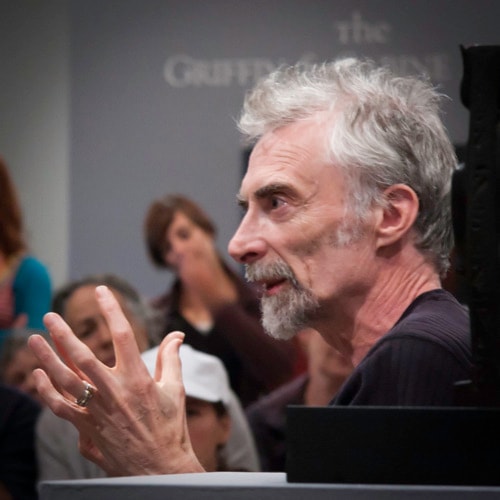When Nick Bantock started to create what would become the Griffin & Sabine trilogy, he wasn’t setting out to create a new literary art genre.
Griffin & Sabine, published in 1988, broke ground in both the literature and art worlds. Their story is told in the form of correspondence; literally postcards and letters bound in book form and combined with Bantocks intense and, at times, disturbing art.
“There was no premeditation in it. You can call it innocent, you can call it naive, or you can just say I was following the artist’s path of enthusiasm,” said Bantock. “I wanted to have this internal dialogue that was both visual and spoken or written word. It wasn’t that I projected on what that might mean to other people. The original print run of Griffin & Sabine was going to be 10,000 pieces. No one could have known that by that Christmas, it would be a million.”
Some of Bantock’s original works from Griffin & Sabine, as well as the 20 years since the publication that catapulted Bantock into world fame, are now on display at the Penticton Art Gallery in Nick Bantock: The Artful Dodger, the first Canadian retrospective of his work. It’s a coup for the gallery to be hosting the exhibition, and though it only contains about 160 pieces of the original 260 in his Denver show, Bantock is pleased to be bringing his work to the Okanagan.
“Being on the road for 20 years doing readings, I found I got a lot more satisfaction doing readings in smaller or middle-sized places. People were somehow less jaded,” said Bancroft. “I lived on Bowen Island, part of the big success of getting the word out about Griffin & Sabine was that the whole island took it to heart and told everyone they knew.”
Having his work embraced like that and the fame that followed was not something Bantock expected, at least consciously.
“When it did, I just had to ride the white pony. It’s always interesting when you look back and you understand, on some level, how much more your subconscious understood what was going on, both in the creative process and in terms of where it fit in the community,” he said. “But I can’t claim knowledge of it beforehand.”
While the show contains work from Griffin & Sabine, there is much more to see, including examples of Bantock’s most recent work.
“The work covers a period of 35 years and fairly evenly across that time. A lot of the really big pieces have been created in the last four years, since I said I don’t want to publish anymore,” said Bantock, who trained as a painter as a youth in Britain. “I just wanted to go back to painting; that is my roots.”
Though the later pieces have a different feel than the earlier works, Bantock said that in both the figurative and non-figurative works, you can see the same person behind them. He admits however, that even he can’t explain why that is.
“I always like that Yogi Berra phrase, ‘When you come to a fork in the road, take it.’ It’s always been like that for me. My attitude is I’ll go both ways,” said Bantock. “In the studio I’ll be working on anywhere between five and 10 pieces at the same time.”
Having so many pieces on the go is one way Bantock avoids creative block. That way, he explained, you simply work with the piece that you have enthusiasm for; where your energy is and where you feel you know what comes next.
Often what you find people doing, Bantock said, is sitting in front of a piece trying to wear it down or letting it wear them down.
“Which is part of that whole western notion of waiting for the muse to come and descend. I much prefer that Latin idea of the duende, the thing that burns through you and you allow the flames to consume,” said Bantock. “Certainly in the last 20 years, that’s been my attitude, that I am the conduit it passes through.”
There is an undeniable intensity to Bantock’s work, which he said is tempered with humour.
“If you are going to be delivering anything resembling a profound message, you also have to make it accessible,” he said.
The kids get it a bit more than adults, who often think they have to be serious. I was watching kids going around the show last night and laughing.”
Two decades of fame have given Bantock a freedom to practise his art as he feels, without having to first sell his ideas to anyone or worry about audience reception.
“For 20 years, if I had an idea, I could carry it through and there was someone there to financially support it and back it. That makes a huge difference. Then, all your energy goes into the work,” he said.
It’s not that Bantock hasn’t had works that have failed or drawn a poor response. But his success has liberated him to follow his “artist’s path” as he sees it before him.
“I’m more interested in the notion of waking myself up, and, if I can, nudging other people to ask the questions that wake themselves up,” he said. “I think the artist has a real role and it’s not to confirm what people already know, but to show that there are multiple universes, parallel ways of being, parallel ways of seeing.
“And there is magic there. If I can show a glimpse of what I am seeing, then some other people will also see that and be invigorated in some way.”
Bantock’s retrospective exhibition continues at the Penticton Art Gallery through to Nov. 6.
